Steering Column
The automotive steering column is a device intended primarily for connecting the steering wheel to the steering mechanism by transferring the driver's input torque from the steering wheel.
A steering column may perform some other secondary functions:
- energy dissipation management in the event of a frontal collision;
- provide mounting for: the multi-function switch, column lock, column wiring, column shroud(s), transmission gear selector, gauges or other instruments as well as the hydraulic or electro motor and gear units found in power steering
- offer height and/or length adjustment to suit driver seating position preference
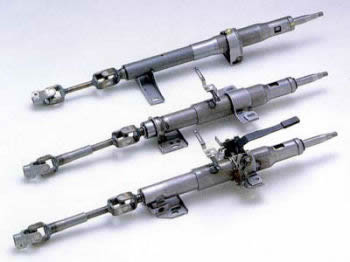
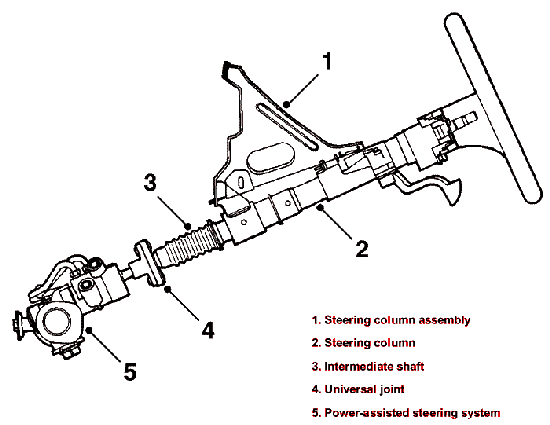
The steering column consists of a collapsible housing containing a collapsible rotating shaft. As a safety measure, the steering column is designed to collapse in the event of a front end collision. If a steering column has collapsed, it must be replaced. The steering shaft is a two or more piece component located inside the steering column. It is supported at the top and the bottom of the steering column by bearings. The steering column housing may also contain gear shift components.
In normal road cars, the steering column is used to mount several accessories. The turn signal switch, head lamp dimmer switch, wiper switch, and ignition switch, can be located on or inside the steering column. Service of the steering column usually requires removal of these components. Care should be taken when the steering column is removed for service. The column should not be dropped, leaned on, or subject to blows to either end. Internal components of the column can shear off, causing the column to partially collapse.
For a auto racing sport in which hundredths of a second can mean the difference between pole position or a mid-field grid slot, a car's ability to handle well is paramount. The steering system provides the driver with his first indication as to how well the car is handling. The steering column is an essential link in the chain of events that sees a twist of the steering wheel turn the car's wheels. The column is joined to the steering wheel at one end and the rack and pinion at the other. This means that the steering column stretches from the edge of the cockpit down to the front survival cell bulkhead.
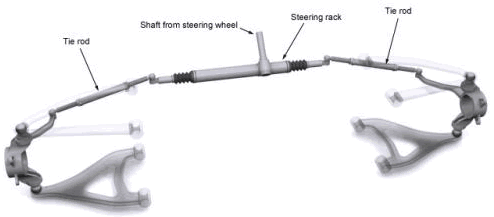
Steering column rack and pinion components in road cars (carbibles.com)
Quite simply, when the driver turns the steering wheel, the column rotates the pinion gear and the rack moves laterally. The track rods are put into action, shifting the wheels. The tie rods are used to link the steering gear to the steering knuckle. The tie rod ends are a ball and socket design that allows the tie rod to flex up and down with the movement of the front suspension. Tie rods should be inspected for excessive movement, grease seal tears, or any visible wear. You should not be able to collapse the ball and socket assembly of the tie rod by attempting to compress it by hand. Any inward movement of the ball and socket should be considered excessive wear.
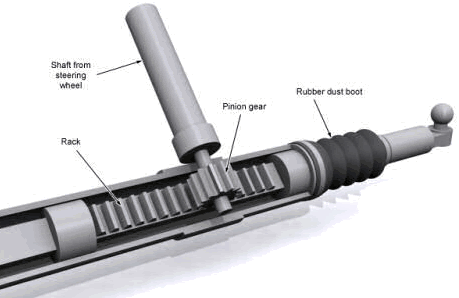
Steering column rack and pinion assembly
Rack and pinion animation
Tie rod ends are a ball and socket design that allows the tie rod to flex up and down with the movement of the front suspension
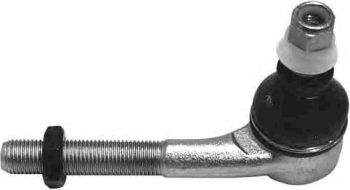
Many modern cars use rack and pinion steering mechanisms, where the steering wheel turns the pinion gear; the pinion moves the rack, which is a linear gear that meshes with the pinion, converting circular motion into linear motion along the transverse axis of the car (side to side motion). This motion applies steering torque to the kingpin of the steered wheels via tie rod and a short lever arm called the steering arm.
The rack and pinion design has the advantages of a large degree of feedback and direct steering "feel"; it also does not normally have any backlash or slack. That's why this system is racing designer first choice. A disadvantage is that it is not adjustable, so that when it does wear and develop lash, the only cure is replacement.
High performance steering column is constructed primarily from carbon fibre or high quality steel, titanium and aluminium, and is made of two tubes. They are linked together by a constant velocity joint, which makes sure that the two parts move at the same speed. It also provides high stiffness and low friction. If there is too much friction or not enough stiffness then it will adversely affect the way the driver can handle the car.
in Formula 1 and some other classes, the column features an electrical plug which connects the steering wheel's electronics to the electronic control unit via a wiring harness. This end of the column also has quick disconnect, which means the driver can remove the steering wheel in a hurry. There's an FIA rule which stipulates that the F1 driver must be able to exit the car in five seconds, so the quick disconnect is very important.
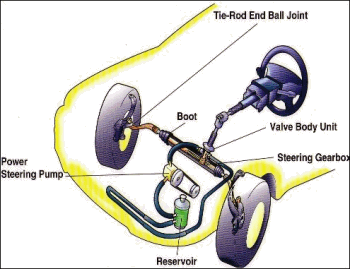
Hydraulically assisted power steering column
At the steering rack end of the column, a splined joint is used to link the two together, this then connects to the power steering valve and then on to the pinion. The power steering pump provides the hydraulic pressure used for steering assistance. The power steering pump is driven by a gear attached to the crankshaft. The power steering pump gear rotates a vane assembly inside a pump ring located inside the pump. Pressure is created by compressing fluid between the vanes and the surface of the pump ring. The pump pressure output is maintained by a flow control valve that contains an internal pressure relief valve. There are two types of power steering pumps used, submerged and non submerged. Both are similar in operation, with the only difference being the type of fluid reservoir used. A submerged type of pump contains the pump and fluid reservoir in one unit. A non submerged uses a remote fluid reservoir for the pump.
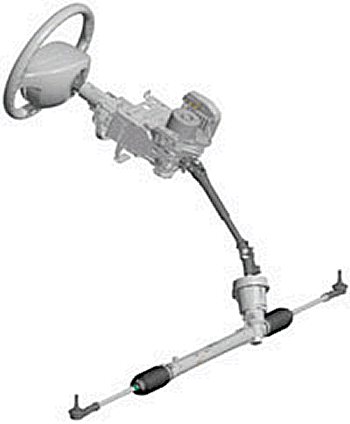
Without the power steering, which in racing environment uses a high pressure hydraulics supply, the driver would have to work the steering twice as hard.
Some modern road cars use instead of hydraulic power steering, electric motor to help driver. Electric power steering is designed to use an electric motor to reduce effort by providing assist to the driver. Most EPS systems have variable assist, which allows for more assistance as the speed of a vehicle decreases and less assistance from the system during high-speed situations. EPS is more efficient than the hydraulic power steering, since the electric power steering motor only needs to provide assistance when the steering wheel is turned, whereas the hydraulic pump must run constantly. In EPS the assist level is easily tunable to the vehicle type, road speed, and even driver preference. An added benefit is the elimination of environmental hazard posed by leakage and disposal of hydraulic power steering fluid.
Another of the requirements for Formula 1 steering column designer is the component laid down by the FIA. This is the aluminium crush tube. They have to perform a crush test in which they drop a weight on the end of the steering column and measure the deceleration. The peak deceleration must be less than 80g in a crash.
For safety reasons all modern cars feature a collapsible steering column (energy absorbing steering column) which will collapse in the event of a heavy frontal impact to avoid excessive injuries to the driver. Non-collapsible steering columns very often impale drivers in frontal crashes. Audi has a retractable wheel system called procon-ten. Procon-ten is a proprietary Safety Restraint System , used by German car manufacturer, from 1986 until the mid-1990s. Audi was one of the last German manufacturers to employ airbags in their cars, mainly due to the high reliability, and cost effectiveness of the technology they trademarked as "procon-ten". Collapsible steering columns were invented by Bela Barenyi .
The Formula 1 steering column takes around ten hours to make, and the team takes three or four spares along to each race. They are inspected after completing 1,500kms and serviced after 3,000kms. A typical service would involve complete disassembly, followed by a crack check of the safety critical parts. It would then be re-assembled - with new parts where necessary - and finally tested on the test rig before being signed-off for use on the circuit.
Having arrived at a design that is both light and stiff yet reliable, the steering column is not changed regularly. However, frequent design reviews are carried out and a new design will be put in place if the monocoque changes sufficiently.
Technical Specification for Formula 1 steering column:
Length: Approx. 950mm
Diameter: Approx. 35mm
Material: Carbon fibre, titanium, steel, aluminium
10.4 Steering :
10.4.1 Any steering system which permits the re-alignment of more than two wheels is not permitted.
10.4.2 Power assisted steering systems may not be electronically controlled or electrically powered. No such system may carry out any function other than reduce the physical effort required to steer the car.
10.4.3 No part of the steering wheel or column, nor any part fitted to them, may be closer to the driver than a plane formed by the entire rear edge of the steering wheel rim. All parts fixed to the steering wheel must be fitted in such a way as to minimise the risk of injury in the event of a driver's head making contact with any part of the wheel assembly.
10.4.4 The steering wheel, steering column and steering rack assembly must pass an impact test, details of the test procedure may be found in Article 16.5.16.6 Steering column crash test :
The parts referred to in Article 10.4.4 must be fitted to a representative test structure; any other parts which could materially affect the outcome of the test must also be fitted. The test structure must be solidly fixed to the ground and a solid object, having a mass of 8kg (+1%/-0) and travelling at a velocity of not less than 7 metres/second, will be projected into it.
The object used for this test must be hemispherical with a diameter of 165mm (+/-1mm).
For the test, the centre of the hemisphere must strike the structure at the centre of the steering wheel along the same axis as the main part of the steering column.
During the test the striking object may not pivot in any axis and the test structure may be supported in any way provided this does not increase the impact resistance of the parts being tested.
The resistance of the test structure must be such that during the impact the peak deceleration of the object does not exceed 80g for more than a cumulative 3ms, this being measured only in the direction of impact.
After the test, all substantial deformation must be within the steering column and the steering wheel quick release mechanism must still function normally.
Here you can learn more about steering wheel and steering technique.







